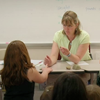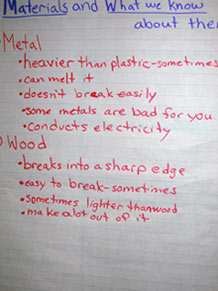What are things in my world made of?
3. Make meaning
Sharing the Findings
Classroom Case


Listening
It's All About Listening
Available online at inquiryproject.terc.edu
Have students meet in a discussion circle with their notebooks. Read the investigation question and ask students if they think they are getting any closer to an answer.
Using the collection of objects you set aside for group discussion, have one team show how they grouped the objects. Establish names for each group of materials, such as metal, wood, plastic, cardboard, rubber, etc.
Ask another team to say what is different about the way they grouped the objects. Ask them to explain why they put different things together.
Explain the way each team grouped these objects by materials is the information the class will use to answer the investigation question. Scientists call would call these observations “data.”
Making Meaning
In this investigation, students’ observations are data they will use to answer the investigation question.
Purpose of the discussion
The purpose of the discussion is for students to use data to
- connect the investigation question and their data.
- reason about why there is variation in the groupings.
- make statements (claims) about the materials that objects from the classroom (things in my world) are made of and to describe the supporting evidence.
Engage students in the focus question
Ask students to look in their Notebooks and see what materials the objects they just worked with are made of.
The investigation question is:
What are things in my world made of? Based on your work with this set of objects, how would we answer this question? [metal, wood, plastic, cardboard, or fabric]
Pay special attention to the objects that cross boundaries. First are the spoons, which are made of three different materials (wood, plastic, and metal). Second are the pencil and the covered wire, which combine two or more different materials in the same object.
How did you decide where to put an object made of more than one material such as the covered wire or the pencil?
Ask students to think about what they know about each of the main materials: metal, wood, plastic. Ask questions like the ones listed below. Collect their ideas in a list for all to see.
- How are the metal objects alike?
- How do you know something is metal?
Repeat for wood and plastic. Once again, point out the investigation question. Invite children to share new insights and questions.
Extending Ideas
(As time permits) Working in pairs, invite children to look around the room and notice objects or parts of the room (e.g., the ceiling, the floor, the walls, the door, the flag) and identify the materials they are made of. Alternatively, this task can be cast as an “I Spy” game. Have pairs share their most interesting finds before ending the lesson.




